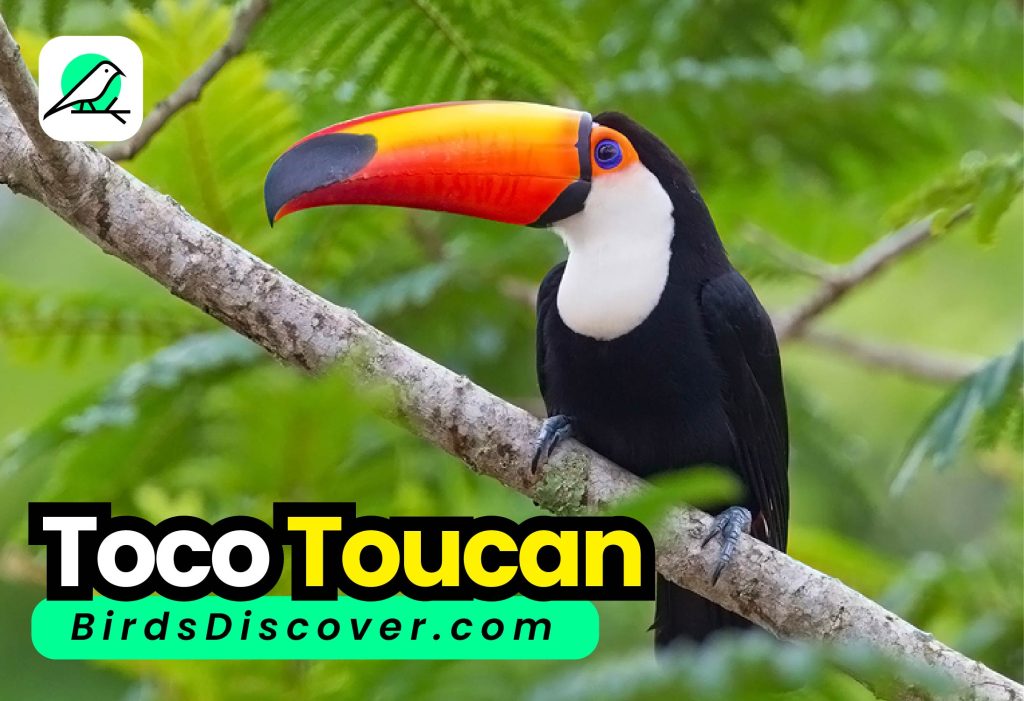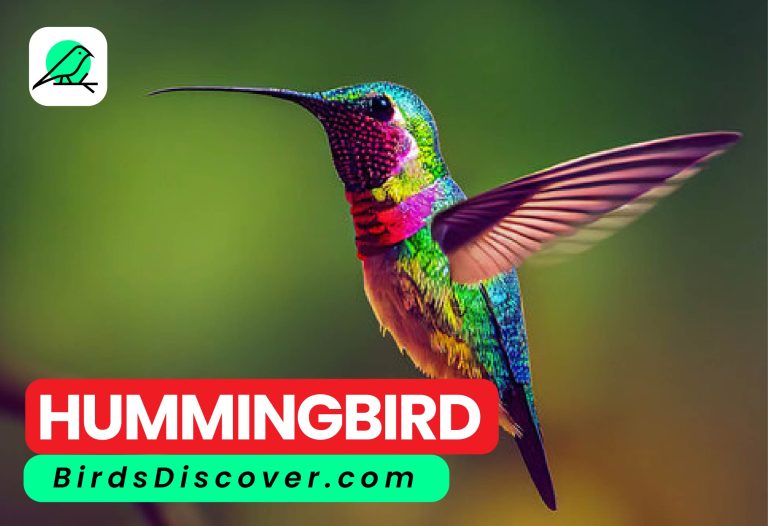Toco Toucan: An In-Depth Look at Ramphastos toco’s Habitat, Diet, and Sounds

Fruits make up a large portion of their diet, and they play an essential role in seed dispersal in their ecosystem.
They produce a range of sounds, from low croaks to high-pitched whistles, showcasing their vocal abilities.
While they are not endangered, protecting their natural habitat is crucial for their continued survival.
Toco Toucan
Toco Toucan, renowned for its striking appearance, is a vibrant bird native to South America’s tropical forests. Characterized by its large, colorful beak, which can reach up to 8 inches in length, this beak is not only a visual marvel but also functional, aiding in foraging and feeding. The Toco Toucan’s plumage is predominantly black with a bright orange belly and a contrasting white throat, making it a visually arresting sight in its natural habitat. These toucans are social creatures, often found in small flocks, and are known for their playful behavior. They primarily feed on fruits, but their diet can also include insects and small animals. The Toco Toucan plays a crucial role in its ecosystem by dispersing seeds, which helps maintain the health and diversity of the forest. Despite their captivating charm, they face threats from habitat loss and the illegal pet trade.
Scientific Classification
| Rank | Category |
|---|---|
| Kingdom | Animalia |
| Phylum | Chordata |
| Class | Aves |
| Order | Piciformes |
| Family | Ramphastidae |
| Genus | Ramphastos |
| Species | R. toco |
Toco Toucan Sound
Summary
The Toco Toucan, a striking bird from South America’s tropical forests, is easily recognized by its large, colorful beak and vibrant plumage. This social and playful species primarily feeds on fruit but also consumes insects and small animals. The toucan aids in forest health by dispersing seeds, contributing to ecosystem diversity. However, the Toco Toucan faces challenges from habitat loss and the illegal pet trade, threatening its population and natural behaviors.

Species in same Genus
| Species | Common Name | Description | Habitat |
|---|---|---|---|
| Ramphastos toco | Toco Toucan | Known for its large, colorful beak and black body with a bright orange belly. | Tropical forests of South America |
| Ramphastos vitellinus | Yellow-ridged Toucan | Features a vivid yellow throat and chest with a contrasting dark beak. | Amazon Basin, Brazil, Colombia |
| Ramphastos tucanus | Citron-throated Toucan | Recognizable by its yellow throat and contrasting black body. | Lowland forests in Central and South America |
| Ramphastos dicolorus | Red-billed Toucan | Has a bright red bill with black and white plumage. | Atlantic Forests of Brazil |
| Ramphastos ariel | Ariel Toucan | Distinguished by its strikingly colorful beak and primarily black body. | Atlantic Forests and parts of the Amazon |
Taxonomy and systematics
The Toco Toucan (Ramphastos toco) is classified within the family Ramphastidae, which encompasses all toucans. Its taxonomy places it in the order Piciformes, alongside woodpeckers and honeyguides. The broader classification is as follows: Kingdom Animalia, Phylum Chordata, Class Aves, Order Piciformes, Family Ramphastidae, Genus Ramphastos, and Species toco. As the largest species within its genus, the Toco Toucan exemplifies the family’s distinctive traits, including its large, colorful beak and vibrant plumage. The genus Ramphastos includes other large toucans, making the Toco Toucan a prominent member of this diverse avian family.
Description
The Toco Toucan (Ramphastos toco) is a strikingly colorful bird known for its large, vivid beak and distinctive appearance. It boasts a predominantly black body with a bright orange belly and a contrasting white throat, creating a dramatic visual contrast. Its most notable feature is its enormous beak, which can reach up to 8 inches in length and is adorned with a mix of orange, yellow, and black. Despite its size, the beak is lightweight due to its hollow structure. The Toco Toucan’s legs and feet are short and sturdy, adapted for climbing and perching. This species is highly social, often found in small flocks, and is known for its playful behavior and vocal calls. It primarily feeds on a diet of fruits, supplemented by insects and small animals, and plays a crucial role in its ecosystem by dispersing seeds. The Toco Toucan inhabits tropical rainforests and is native to countries in South America, including Brazil, Argentina, and Paraguay.
Bill
The bill of the Toco Toucan (Ramphastos toco) is one of its most distinctive features. It is exceptionally large, measuring up to 8 inches (20 cm) in length, and is characterized by its bright orange coloration with a black tip and edges. The bill is lightweight despite its size due to its hollow, sponge-like structure, which helps it to be more manageable during feeding and maneuvering. Its vibrant colors serve not only as a visual spectacle but also play a role in communication and social interactions among toucans. The bill is used primarily for reaching and consuming fruits, as well as for establishing territory and attracting mates.

Vocalization
The Toco Toucan (Ramphastos toco) is known for its distinctive vocalizations, which include a variety of calls that can be described as a series of hoarse, croaking sounds. These calls are often loud and resonant, used for communication within flocks and during territorial disputes. One of their most common vocalizations is a repetitive “kra-kra-kra” sound, which can be heard echoing through the forest. These vocalizations help toucans maintain social bonds, signal alarm, and coordinate movements within their group. The unique quality of their calls, combined with their bright appearance, makes the Toco Toucan a remarkable presence in its tropical habitat.
Distribution and Habitat
Certainly! Here are the distribution and habitat details of the Toco Toucan (Ramphastos toco) in points:
- Distribution:
- Found across South America.
- Native to Brazil, Argentina, Paraguay, and parts of Bolivia.
- Habitat:
- Prefers tropical rainforests and lowland forests.
- Inhabits both primary and secondary forests, including forest edges.
- Can be found in foothill forests and areas with scattered trees.
- Thrives in regions with abundant fruiting trees and a diverse range of food sources.
Behavior
The Toco Toucan (Ramphastos toco) exhibits a range of engaging behaviors. Social and often found in small flocks, it is known for its playful and interactive nature. These toucans frequently engage in vocal communication, using their distinctive calls for social bonding and territorial disputes. They are adept climbers, using their beaks and feet to navigate tree branches and forage for fruit. Toco Toucans often display a variety of behaviors, including mutual grooming and group foraging. Their vibrant beaks are not only for feeding but also play a role in attracting mates and establishing dominance. Additionally, they are known for their occasional displays of aggression towards rivals, especially during the breeding season.
Diet
The Toco Toucan (Ramphastos toco) primarily feeds on a diet rich in fruits, which constitute the majority of its nutrition. It consumes a variety of fruits, including figs, bananas, and berries, using its large, colorful beak to grasp and manipulate them. Besides fruit, the Toco Toucan also eats insects, small reptiles, and occasionally small birds or eggs, supplementing its diet with these protein sources. The toucan’s beak is well-adapted for reaching fruit on high branches and handling large, tough-skinned fruits. By dispersing seeds through its droppings, the Toco Toucan plays a crucial role in maintaining the health and diversity of its forest habitat.

Breeding
| Aspect | Details |
|---|---|
| Breeding Season | Typically from September to March, varying by region. |
| Nesting | Nests in tree cavities, often using old woodpecker holes. |
| Clutch Size | Usually 2 to 4 eggs per clutch. |
| Egg Incubation | Both parents incubate the eggs for about 16 to 20 days. |
| Fledging | Chicks fledge approximately 6 to 8 weeks after hatching. |
| Parental Care | Both parents are involved in feeding and caring for the young. |
Relationships with different Species Culture
| Species | Relationship with Toco Toucan |
|---|---|
| Other Toco Toucans | Often found in small flocks, they exhibit social behaviors like mutual grooming and foraging together. Territorial disputes can occur, especially during the breeding season. |
| Other Ramphastos Species | Interactions with other species in the Ramphastos genus, such as the Yellow-ridged Toucan (Ramphastos vitellinus) and the Citron-throated Toucan (Ramphastos tucanus), can involve competition for food resources and nesting sites. |
| Woodpeckers | Toco Toucans may use abandoned woodpecker holes for nesting, thus benefiting from the woodpeckers’ excavation activities. |
| Predators | The Toco Toucan’s bright plumage and loud calls can attract attention from predators. Predators of Toco Toucans include hawks and large snakes. |
| Fruit Trees and Plants | The Toco Toucan plays a role in seed dispersal for many fruit-bearing trees, helping maintain forest diversity. Its feeding habits can influence the growth and spread of certain plant species. |
Culture
The Toco Toucan (Ramphastos toco) holds a notable place in the cultural landscape of its native South America. Revered for its vibrant plumage and striking beak, it often appears in local folklore and art. Its colorful appearance has made it a popular symbol of tropical wildlife, frequently featured in regional crafts, paintings, and carvings. In many indigenous cultures, the toucan is seen as a symbol of beauty and vibrancy, reflecting the rich biodiversity of the rainforest. Its vocalizations and distinctive calls contribute to its cultural presence, adding a unique auditory signature to the tropical soundscape. However, the Toco Toucan’s presence in culture is not limited to local traditions; it also holds significance in global popular culture. As a mascot and emblem, it represents the exotic allure of tropical wildlife in various media, including advertisements, logos, and educational materials. Despite its cultural prominence, the Toco Toucan faces challenges from habitat loss and the illegal pet trade, which threaten its survival and cultural legacy. Efforts to protect its natural habitat also help preserve the cultural and ecological significance of this remarkable bird.

Common Names in Different Languages
| Language | Common Name |
|---|---|
| English | Toco Toucan |
| Spanish | Tucán de pico grande |
| Portuguese | Tucano-de-bico-grande |
| French | Toucan toco |
| German | Toco-Tukan |
| Italian | Tucano dal becco grande |
| Dutch | Grote Toekan |
| Japanese | トコツツドリ (Toko tsutsudori) |
| Chinese | 大嘴鸟 (Dà zuǐ niǎo) |
FAQS
What is the primary diet of the Toco Toucan?
The Toco Toucan primarily feeds on fruits, including figs, bananas, and berries. It also consumes insects, small reptiles, and occasionally small birds or eggs.
Where can you find Toco Toucans in the wild?
Toco Toucans are native to South America, found in countries such as Brazil, Argentina, Paraguay, and parts of Bolivia. They inhabit tropical rainforests and forest edges.
How do Toco Toucans communicate?
Toco Toucans communicate using a variety of vocalizations, including loud, croaking calls. These sounds are used for social bonding, signaling alarm, and establishing territory.
What is unique about the Toco Toucan’s beak?
The Toco Toucan’s beak is large, colorful, and can reach up to 8 inches in length. Despite its size, it is lightweight due to its hollow structure, which aids in foraging and social interactions.
How do Toco Toucans contribute to their ecosystem?
Toco Toucans play a crucial role in seed dispersal. By consuming fruits and excreting the seeds, they help maintain the health and diversity of their forest habitat.






